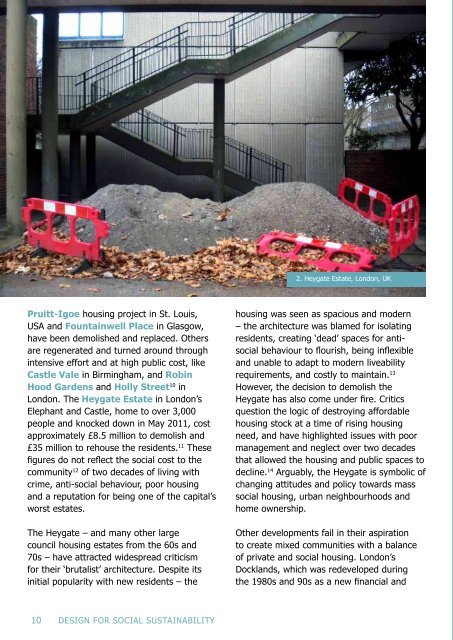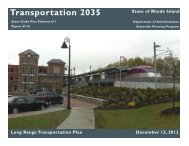Design for Social Sustainability â Saffron Woodcraft, 2010
Design for Social Sustainability â Saffron Woodcraft, 2010
Design for Social Sustainability â Saffron Woodcraft, 2010
You also want an ePaper? Increase the reach of your titles
YUMPU automatically turns print PDFs into web optimized ePapers that Google loves.
2. Heygate Estate, London, UK<br />
residential centre, has been widely criticised<br />
<strong>for</strong> focusing on luxury flats to house financial<br />
sector workers, rather than creating mixed<br />
communities with af<strong>for</strong>dable housing <strong>for</strong><br />
low-income families living in the East End.<br />
The result is long term tensions between<br />
existing communities and new residents, and<br />
problems with anti-social behaviour and local<br />
cohesion.<br />
Be<strong>for</strong>e the current boom in creating new<br />
communities, the English New Towns<br />
was one of the world’s most sustained newtown<br />
development programmes; creating<br />
32 settlements between 1946 and 1970 and<br />
housing over three million people. Experience<br />
from the English New Towns has shown that<br />
ignoring the social dimensions of new places<br />
and the aspirations and opinions<br />
of residents can lead to long term<br />
problems.<br />
opportunities to meet other residents, build<br />
local networks and shared social experiences.<br />
Research by the Joseph Rowntree Foundation<br />
exploring the success and sustainability of<br />
mixed communities from the perspective<br />
of residents identifies nine priorities <strong>for</strong><br />
new communities. These are: good quality<br />
housing; good schools; safe, clean and<br />
friendly neighbourhoods; community<br />
outreach workers; pre-school child care;<br />
well integrated social housing; careful interagency<br />
planning; neighbourhood staff; and<br />
supervision of open spaces and parks. 18<br />
Without these social supports new<br />
settlements struggle to become cohesive,<br />
living communities with a sense of place,<br />
belonging and identity.<br />
Pruitt-Igoe housing project in St. Louis,<br />
USA and Fountainwell Place in Glasgow,<br />
have been demolished and replaced. Others<br />
are regenerated and turned around through<br />
intensive ef<strong>for</strong>t and at high public cost, like<br />
Castle Vale in Birmingham, and Robin<br />
Hood Gardens and Holly Street 10 in<br />
London. The Heygate Estate in London’s<br />
Elephant and Castle, home to over 3,000<br />
people and knocked down in May 2011, cost<br />
approximately £8.5 million to demolish and<br />
£35 million to rehouse the residents. 11 These<br />
figures do not reflect the social cost to the<br />
community 12 of two decades of living with<br />
crime, anti-social behaviour, poor housing<br />
and a reputation <strong>for</strong> being one of the capital’s<br />
worst estates.<br />
The Heygate – and many other large<br />
council housing estates from the 60s and<br />
70s – have attracted widespread criticism<br />
<strong>for</strong> their ‘brutalist’ architecture. Despite its<br />
initial popularity with new residents – the<br />
housing was seen as spacious and modern<br />
– the architecture was blamed <strong>for</strong> isolating<br />
residents, creating ‘dead’ spaces <strong>for</strong> antisocial<br />
behaviour to flourish, being inflexible<br />
and unable to adapt to modern liveability<br />
requirements, and costly to maintain. 13<br />
However, the decision to demolish the<br />
Heygate has also come under fire. Critics<br />
question the logic of destroying af<strong>for</strong>dable<br />
housing stock at a time of rising housing<br />
need, and have highlighted issues with poor<br />
management and neglect over two decades<br />
that allowed the housing and public spaces to<br />
decline. 14 Arguably, the Heygate is symbolic of<br />
changing attitudes and policy towards mass<br />
social housing, urban neighbourhoods and<br />
home ownership.<br />
Other developments fail in their aspiration<br />
to create mixed communities with a balance<br />
of private and social housing. London’s<br />
Docklands, which was redeveloped during<br />
the 1980s and 90s as a new financial and<br />
The review of evidence and<br />
experience from new settlements<br />
around the world highlights the<br />
fragility of new communities and<br />
the length of time it takes <strong>for</strong> new<br />
places to become established:<br />
Some evidence suggests that<br />
it takes up to 15 years be<strong>for</strong>e<br />
local social networks develop<br />
fully. 15<br />
Research in China reports that social<br />
interaction in neighbourhoods is hindered<br />
<strong>for</strong> long periods of time after urban<br />
redevelopments. 16 It identified the need<br />
<strong>for</strong> good quality social infrastructure and<br />
local services, support <strong>for</strong> community<br />
development, opportunities <strong>for</strong> residents<br />
to get involved in local decision making,<br />
and shared social spaces and activities in<br />
new communities. 17 Equally important are<br />
the less visible types of support that create<br />
3. Futurecommunities.net<br />
Evidence shows that communities without<br />
adequate local facilities, services and<br />
community support suffer from a wide range<br />
of social problems. Lessons from English<br />
new communities identify higher than<br />
average rates of isolation and mental health<br />
problems, often caused by poor transport<br />
connections that isolate people from friends,<br />
family and local jobs. Other problems are<br />
inflexible housing stock that makes it hard<br />
to attract and retain residents, and a lack<br />
of opportunities <strong>for</strong> residents to influence<br />
10 DESIGN FOR SOCIAL SUSTAINABILITY<br />
THE CASE FOR SOCIAL SUSTAINABILITY 11
















